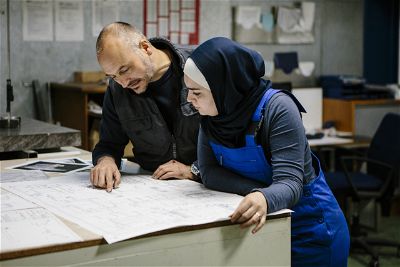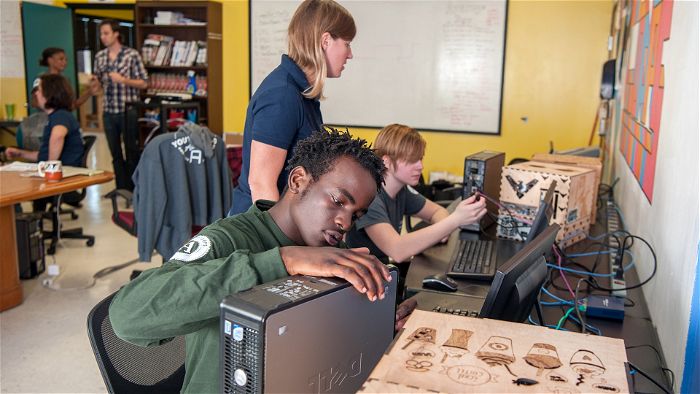
American Rescue Plan funds can jump-start stalled opportunities for youth
October 27, 2021
At a Glance
By investing in programs that help young people engage with education and career development, we can transform the labor market for the better.
The $1.9 trillion American Rescue Plan (ARP) may have entered—and quickly exited—national consciousness six months ago, but its effects are only beginning to be felt at the state and local level. The rescue plan allotted $330 billion to support state and local fiscal recovery, with the first outlay released in May 2021 and the second by May 2022. State and local leaders are working in real time to deploy these dollars to stabilize their budgets and respond to COVID-induced disruptions.
By design, ARP dollars are very flexible, and leaders have many demands on their budgets. We argue that investing in educational and career opportunities for young adults is a smart bet on the future. COVID-19 upended two major institutions shaping young people’s lives and early pathways—education and the job market—with potentially disastrous effects. Without targeted policy responses, young people may suffer long-term consequences, especially those whose connections to school and work were already tenuous. Social exclusion and inequality at such a scale will seriously threaten social cohesion and community well-being.
ARP dollars and other federal investments offer the chance to disrupt long-established patterns of who succeeds in education and the labor market, and who doesn’t. We should not waste this opportunity.
American Rescue Plan dollars and other federal investments offer the chance to disrupt long-established patterns of who succeeds in education and the labor market, and who doesn’t. We should not waste this opportunity.
From a chronic condition to an acute crisis
The path from high school through postsecondary education to a good job has long been more like an obstacle course. Before the pandemic, millions of young adults cycled through postsecondary education, unemployment, and low-wage jobs without gaining traction. Over 4 million young people ages 16-24 were out of school and out of work, and another 7 million worked in low-wage jobs with relatively slim chances of advancement. Only 60 percent of students who enrolled in a two- or four-year program earned a degree within six years, prompting some researchers to describe incoming students as facing “coin-toss odds of success.” And the problem doesn’t solve itself over time: More young people are disconnected from school and work at age 20 and 26 than at age 18.
Fast-forward to the ongoing COVID-19 crisis: Unemployment among 16-24-year-olds remains at 9.9 percent as of August 2021, considerably higher than the overall unemployment rate of 5.2 percent. As many as one in three young adults—a total of more than 10 million people—may now be out of work and not attending school. Undergraduate college enrollment fell by 3.6 percent in the fall of 2020 and another 5 percent in the spring, the most significant declines in years. A Strada survey of recent high school graduates suggests that many young adults are feeling overwhelming levels of uncertainty, anxiety, and confusion about their future and are not sure how to make wise decisions about their education or career.
Investing in the education and career opportunities of young adults is a smart bet on the future.
ARP dollars can build stronger guardrails
With federal ARP funding, states and localities have a unique opportunity to counteract these trends by creating more pathways to opportunity and quality jobs. ARP provides $220 billion in funding to states and $130 billion to cities and counties via the Treasury Department’s state and local fiscal recovery funds.
Any given city, county, or state could reasonably choose various strategies aimed broadly at 1) helping young people enroll in and complete postsecondary education or training, and 2) providing young people with paid work experiences coupled with career guidance and skills development. Program design and implementation will determine whether these initiatives have a long-term impact or represent a burst of activity that fades away in a year or two.
To ensure a lasting impact, we recommend that policy initiatives incorporate the following principles:
- Define your population
- Invest in local assets
- Make it personal
Define your population. “Young people” is often too broad a term: A 19-year-old a few credits shy of a high school diploma will need a different intervention than a 19-year-old who left school in the 10th grade, and both will need a different intervention than a 23-year-old with a high school diploma and a low-wage job. Some young adults are coming out of the child welfare or juvenile justice systems, some lack access to stable housing, and some are parents themselves. Some were once enrolled in college but left for financial or other reasons and may have student debt.
State and regional data can identify the key points where young people disengage from education and the relative size of different subgroups. Then, it’s time for judgment calls. Assess your population data against local assets. Where is the best match between need and capacity? What complements the stated priorities of elected officials and other local leaders?
Invest in local assets. Don’t start from scratch, and don’t duplicate. Building a new stand-alone program practically guarantees an expiration date—the program will end when the ARP funding ends. Instead, consider what organizations in your area are already doing. Is there a local re-engagement or opportunity youth network with expertise in creating pathways for young people? A YouthBuild or service and conservation corps with strong outcomes? A college promise or college access program? Job training programs based on a solid labor market analysis with employer buy-in? A community college or state university initiative to improve student retention and graduation? Is there an opportunity to connect to registered apprenticeships?
Look into whether any of these existing initiatives could use ARP money for improvement or expansion. For instance, they could design more robust services and partnerships, conduct human-centered design exercises for quality improvement, invest in technology systems to improve performance measurement, or fill any number of gaps. Investing in organizational and program capacity will generate returns in the long run.
Make it personal. The ability to build and maintain supportive relationships with young people grounded in safety, trust, and respect should be a core performance measure of any program. Persistent and intentional outreach and retention strategies should be baked into organizational structures and staff job descriptions as well. Whether staff are helping young people prepare for the GED, enroll in college, get a child care voucher, or practice job interview skills, success depends on their ability to develop trust and respect in their interactions with young people.
Trust-based relationships are also important in building social networks and providing career navigation in an increasingly unpredictable labor market. Career navigators can help young people understand their strengths and determine how to translate their skills into occupations where they can thrive. Programs can then introduce participants to area employers or workers in their industries of interest, which can help them build the networks that alert them to job opportunities. An increasing number of tech-enabled user-friendly platforms and services are also emerging to make these supports possible for even more young people.
For millions of young people, and disproportionately those who are Black and Latinx, we have normalized a path from high school to a low-wage service sector job with limited advancement options. State and local ARP funds offer a rare chance to disrupt this pattern and provide support for the organizations committed to doing this work in our communities. The opportunities afforded to young people today will inform the stability of our communities tomorrow, and we must act.
Related Content

Expanding Apprenticeship to Opportunity Youth
Learn More About Apprenticeship and Work-Based Learning for Opportunity Youth With the support of the U.S. Department of Labor’s Apprenticeship Expansion and Modernization Fund, JFF is increasing access to Registered Apprenticeship programs for opportunity youth—young…

Young Adult Talent Development Network
The Young Adult Talent Development Network is comprised of leaders of more than 35 national and local organizations that are leaders in young adult talent development and employer engagement. The Young Adult Talent Development Network…

JFF's Framework for a High-Quality Pre-Apprenticeship Program: Opportunity Youth
This pre-apprenticeship framework outlines strategies and promising practices for developing high-quality programs that serve opportunity youth participants. Acknowledgments We would like to thank the U.S. Department of Labor for providing the funding to support this…